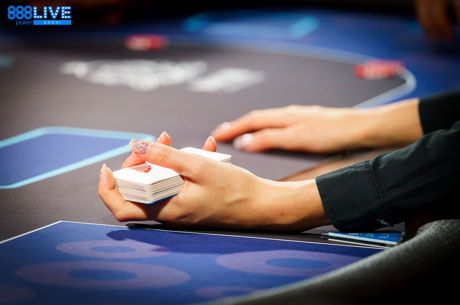Strategy Vault: Limit Hold'em for No-Limit Players in H.O.R.S.E.

Digging deep into the PokerNews strategy archives can lead to a buried treasure, so we'll be unearthing a few gems for your viewing pleasure. For this edition of the Strategy Vault series, we're sticking with H.O.R.S.E. and will focus on the first letter, hold'em. While hold'em is poker's most popular format, limit hold'em takes a backseat to no-limit hold'em. If you want to succeed in H.O.R.S.E., though, you'll have to be able to play limit hold'em with the best of them.
The lament of the no-limit hold'em player forced to play limit hold'em is often that "opponents can't be forced to fold." There is some merit to this sentiment; with betting limits structured into fixed amounts, the best weapon of the no-limit hold'em player �� the aggressive, pressure bet for most or all of an opponent's chips �� is removed from the player's arsenal. This column has discussed previously that the closest a limit hold'em player can come to a pressure bet is a check-raise on the flop or turn. Check-raises in limit hold'em typically demonstrate extreme strength, and at the right juncture can induce a fold from a player not willing to invest several extra bets to find out that his hand is second best.
Limit hold'em, however, represents twenty percent of the typical H.O.R.S.E. rotation. If a player wants to play H.O.R.S.E. at a high level, he needs to make some adjustments to his no-limit hold'em game in order to succeed at limit hold'em.
Knowing the Math
Many no-limit hold'em players aren't the best at calculating the odds that the pot is laying them (or that they are giving to an opponent by making a bet of a certain size). They are able to get away without knowing the math because no-limit hold'em rewards aggression and the player who makes the "pressure bet" to such a degree that math is often taken out of the equation entirely. Stack sizes also inform the math discussion (or lack thereof) in no-limit hold'em.
Limit hold'em, on the other hand, is all about the math. With betting in fixed limits, stack sizes become irrelevant and the ability to make a pressure bet is sharply curtailed. When faced with a decision to call or fold in a situation in which a player clearly trails the hand of his opponent, it all becomes a question of math. What price is the pot laying? What are the odds of making a winning hand? If the pot is laying a price that is greater than the odds of making a winning hand, a call is automatic. This is why great no-limit hold'em players like Phil Hellmuth feel less skill is required for limit games than for no-limit games. A player doesn't have to trust his instincts, his poker sense, and his player-reading ability in limit hold'em as much as one does in no-limit hold'em. One can rely on the math instead and turn the hand into something of a card-catching contest.
One upside of this is that, because the betting limits are fixed in limit hold'em, it's very easy to keep track of the size of the pot. The pot can be calculated in terms of bets rather than fixed dollar amounts. For example, if one player raises before the flop and both blinds call, six small bets are in the pot. If the small blind bets out after the flop and the big blind folds, the original raiser is getting seven-to-one on his money to see the turn. If he calls and the small blind again bets the turn, the original raiser is getting five-to-one (eight small bets are equal to four big bets, plus the bet made by the small blind on the turn).
"It's Just One Bet"
One of the biggest mistakes that no-limit hold'em players make when playing limit hold'em is falling into the trap of "It's just one bet." As a result, they try to limp into the pot before the flop with far too wide a range of hands, naively assuming "it's just one bet" despite the possibility of a raise behind them. If they catch a pair on the flop (even a small pair), they may rationalize going all the way to the river against an opponent demonstrating strength by repeating the "one bet" mantra and calling on the flop and turn. Before they realize it, they've invested two to three big bets on a board of 5?K?Q?8? with a starting hand of 5?6? and they've completely moved away from the aggressive style that is a hallmark of success in the no-limit game. As poker theorist Abdul Jalib famously once said, "Your opponent cannot fold if you do not bet or raise." No-limit players should be very careful about falling into the trap of calling because "it's just one bet."
Misplaying the River
By the time a hand reaches the river in limit hold'em, typically there are between five and seven big bets in the pot. Given those numbers, it is almost impossible to successfully bluff-raise a savvy opponent, but time and again no-limit hold'em players try to do so because they just don't realize that it's (a) too easy and (b) usually correct for the initial bettor to call. If a player is confident enough to bet his hand on the river, and his opponent is not a total rock, then after a raise by the opponent, the pot back to the initial bettor will contain anywhere from eight to 10 bets in it. If he is getting 10-1 on his call, he almost always will call �� the showdown value of his hand combined with the probability of a bluff from his opponent is usually enough to make a call profitable. It's a very rare case where a player that is raised on the river will throw his hand away, absent a dead read on the raiser.
This shouldn't be confused with bluff-betting the river. Bluff-betting the river can often work due to the fact that the pot is smaller (meaning worse pot odds for an opponent) and due to the fact that weak hands held by an opponent that might be checked down will be folded in the face of a bet.
It's not an easy process to switch gears from playing no-limit hold'em to playing limit hold'em, but it doesn't have to be a painful process either. These are but a few tips to help ease the transition along the way to playing a better limit hold'em game and therefore a better H.O.R.S.E. game. Thankfully, limit hold'em is one of the few H.O.R.S.E. rotation games that's easy to practice.
This article was originally published on Nov. 8, 2008.
Want to learn more about the different variants of H.O.R.S.E.? Check out the Poker Rules section here on PokerNews.
To stay on top of the poker world, follow us on Twitter and like us on Facebook.








